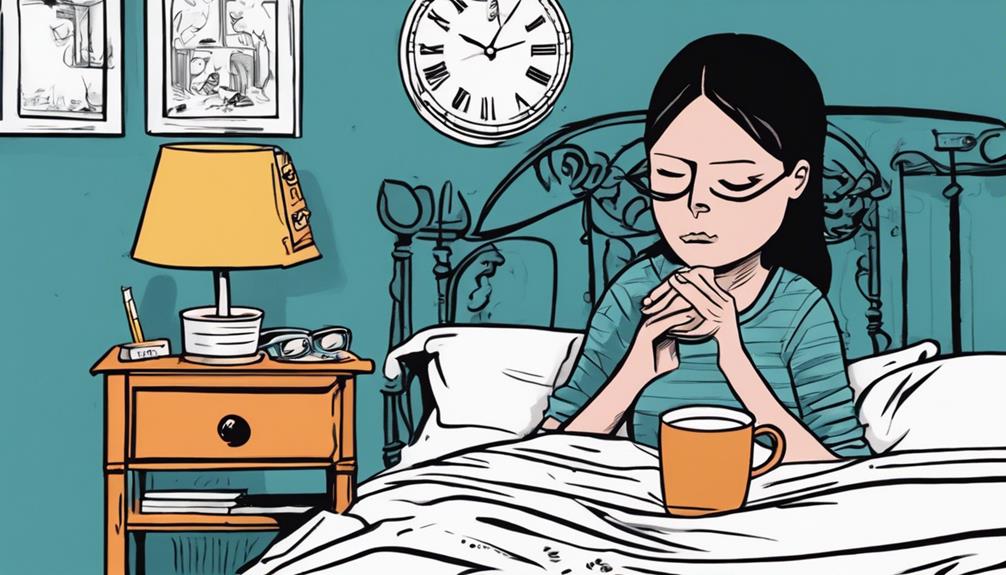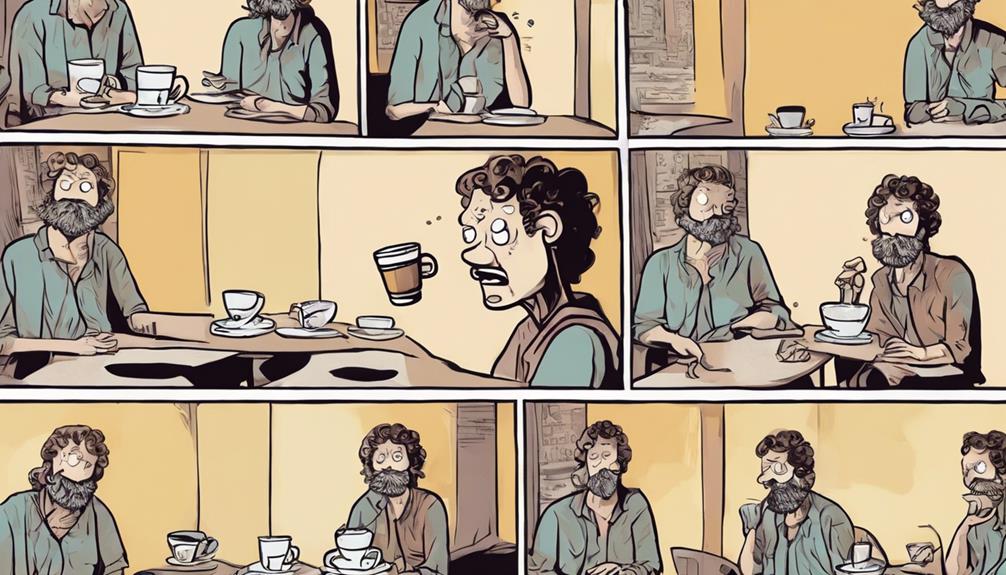To reduce the effects of a caffeine high, it is important to hydrate and flush out any excess caffeine from the body. Engaging in light physical activities such as walking can help burn off extra energy. Taking deep breaths can help calm nerves and counteract feelings of anxiousness. Herbal teas like chamomile are known to promote relaxation. Consuming magnesium-rich foods like nuts and seeds can help alleviate jitters and promote a sense of calm. By following these simple strategies, you can effectively combat the effects of caffeine quickly.
Key Takeaways
- Engage in light physical activity like walking to burn off excess energy and reduce jitters.
- Practice deep breathing exercises to calm nerves and reduce anxiousness.
- Drink plenty of water to flush out excess caffeine and alleviate jitteriness.
- Try herbal teas like chamomile to promote relaxation and counteract caffeine effects.
- Incorporate magnesium-rich foods like nuts and seeds to alleviate coffee jitters and promote calmness.
Understanding Caffeine Overconsumption
If you ingest too much caffeine, you may experience symptoms such as jitteriness, restlessness, and rapid heartbeats. Excessive consumption of caffeine, more than 400mg, can lead to unpleasant effects on your body.
When your heart rate spikes and you feel jittery, addressing the situation promptly is key. Engaging in light physical activity, such as a short walk, can help your body metabolize the caffeine faster. Deep breathing exercises can also assist in calming your nervous system and reducing the symptoms of overconsumption.
Remember to drink plenty of water to stay hydrated and aid in flushing out the excess caffeine from your system.
Being mindful of your caffeine intake is crucial to avoid these uncomfortable side effects. If symptoms like irregular heartbeat or dizziness persist, seek immediate medical attention. Monitoring your coffee consumption and being aware of how much caffeine your body can tolerate is vital for maintaining your well-being.
Maximum Caffeine Intake Recommendations

The recommended maximum daily caffeine intake for healthy adults, according to the FDA, is up to 400 milligrams.
To make sure you stay within safe limits and avoid experiencing unpleasant symptoms, consider the following:
- Moderate Consumption: Health benefits are associated with consuming 3 to 4 cups of coffee per day.
- Excessive Caffeine: Going over the advised limit can lead to discomfort such as jitters.
- Symptoms of Consuming: Watch out for signs like nervousness, headache, shakiness, and dizziness.
- Irregular Heartbeat: Excessive caffeine intake may also result in irregular heartbeats, indicating you've had too much.
It's important to be mindful of your daily routine and how much caffeine you're consuming. By keeping an eye on your intake and sticking to the recommended amount, you can enjoy the benefits of caffeine without experiencing the negative effects associated with exceeding the maximum limit.
Managing Excessive Caffeine Symptoms

To effectively manage excessive caffeine symptoms, hydrate with water to help flush out the excess caffeine from your body. Engaging in light physical activity like walking can also assist in calming jitteriness. Try practicing deep breathing techniques to alleviate any anxiety resulting from overconsumption of caffeine. Sipping on herbal teas, such as chamomile, can promote relaxation and help offset the effects of caffeine. It's essential to avoid further caffeine intake and focus on calming activities to bring down a coffee high.
| Caffeine Consumption | Hydrate | Physical Exercise |
|---|---|---|
| Deep Breathing Exercises | Herbal Infusions | Anxiety |
| Counteract Effects | Relaxing Activities |
Impact on Heart Health

Excessive caffeine consumption can lead to a temporary increase in your heart rate and blood pressure.
If you have existing heart conditions, consuming too much caffeine can put you at risk of irregular heart rhythms.
Remember to seek immediate medical attention if you experience an irregular heartbeat or dizziness after consuming caffeine.
Heart Rate Effects
Caffeine's impact on your heart rate can be vital, especially when consumed in large quantities. Here's what you need to know about how caffeine affects your heart rate:
- Temporary Increase:
Caffeine can cause a temporary surge in your heart rate and blood pressure, which may lead to palpitations or a rapid heartbeat.
- Irregular Heart Rhythms:
Excessive caffeine consumption can trigger irregular heart rhythms, particularly in individuals with underlying heart conditions. This can manifest as arrhythmias or palpitations.
- Anxiety Exacerbation:
If you're prone to anxiety, caffeine can exacerbate these symptoms by further increasing your heart rate and inducing feelings of restlessness.
- Seeking Medical Help:
It's essential to seek medical assistance if you experience symptoms like irregular heartbeat, dizziness, or chest pain after consuming coffee or other caffeinated beverages, especially if you have pre-existing heart conditions. Consulting a healthcare provider about your caffeine intake is vital for managing your heart health effectively.
Cardiac Health Concerns
Caring for your heart health involves understanding how caffeine consumption can impact your cardiac well-being. Excessive caffeine can lead to a temporary increase in heart rate and blood pressure, potentially posing risks for individuals with heart conditions.
Those with pre-existing heart issues are particularly vulnerable to experiencing irregular heart rhythms after consuming too much caffeine, necessitating prompt medical attention. It's essential for individuals with heart conditions to discuss their caffeine intake with a healthcare provider to effectively manage potential risks.
Additionally, excessive caffeine consumption can exacerbate anxiety in predisposed individuals, underscoring the importance of being aware of and moderating caffeine intake. Monitoring for cardiovascular symptoms such as irregular heartbeat and dizziness is essential for individuals with heart health concerns, as these signs could indicate a need for medical evaluation.
Being mindful of how caffeine affects your heart can help you make informed choices to safeguard your cardiac well-being.
Recovery Strategies After Overconsumption

If you've overdone it with caffeine, recovery strategies can help ease the effects.
Wait it out for a few hours, stay hydrated, and consider replenishing electrolytes if necessary.
Engaging in light physical activity and relaxation techniques like deep breathing can also aid in the process.
Recovery Tips
After overindulging in coffee, implementing effective recovery strategies is essential to alleviate the effects of caffeine overload on your body.
Here are some tips to help you bounce back from excessive coffee consumption:
- Wait it Out: It takes about 4 to 6 hours for caffeine levels to naturally decrease in your system, so give your body time to recover.
- Stay Hydrated: Drinking plenty of water can help flush out the excess caffeine and reduce the side effects of overconsumption.
- Move Around: Engaging in light physical activity like walking can aid in metabolizing the excess caffeine and alleviate jitteriness.
- Relax and Recharge: Practice deep breathing exercises or consider meditation to help counteract caffeine-induced jitters and withdrawal symptoms.
Post-Consumption Strategies
To effectively recover from overconsumption of caffeine, implementing post-consumption strategies is essential to mitigating the adverse effects on your body.
After consuming too much caffeine, waiting around 4 to 6 hours for it to naturally leave your system is pivotal.
Avoid further caffeine intake and focus on staying hydrated with water to help reduce the symptoms of too much caffeine.
If needed, consider replenishing electrolytes to restore balance in your body.
Engaging in light physical activity, like walking, can also aid in metabolizing the excess caffeine.
Additionally, practicing deep breathing exercises and meditation can help calm the jittery effects of overconsumption, bringing your body back to normal.
Remember that moderation is essential when it comes to caffeine consumption, as it has its health benefits but too much can lead to unwanted effects.
How to Get Rid of Coffee Jitters

Combatting coffee jitters can be achieved through simple strategies like hydrating with water and engaging in light physical activity. Here are some effective ways to get rid of those caffeine jitters:
- Hydrate with Water:
Drinking plenty of water helps to flush out the excess caffeine in your system, reducing the jittery feeling.
- Engage in Light Physical Activity:
Taking a short walk or doing some light exercises can help burn off the extra energy from caffeine and ease the jitters.
- Practice Deep Breathing Exercises:
Deep breathing can help calm your nerves and reduce the anxiousness often associated with coffee jitters.
- Try Herbal Tea:
Sipping on herbal teas like chamomile can promote relaxation and counteract the effects of caffeine, helping to soothe your nerves.
In addition to these strategies, incorporating magnesium-rich foods into your diet, such as nuts or seeds, can also aid in alleviating coffee jitters and promoting a sense of calm.
Frequently Asked Questions
How Do You Calm Down From a Coffee High?
To calm down from a coffee high, hydrate with water, engage in light physical activity, practice deep breathing, sip on herbal teas like chamomile, avoid more caffeine, and choose foods rich in magnesium and potassium to counteract the effects.
How Do You Reduce the Effects of Strong Coffee?
To reduce the effects of strong coffee, hydrate with water, move with light activity, breathe deeply, sip herbal tea like chamomile, and snack on magnesium or potassium-rich foods. Avoid more caffeine for a balanced recovery.
How Do You Calm Coffee Induced Anxiety?
To calm coffee-induced anxiety, try deep breathing exercises, go for a walk, or sip on herbal teas like chamomile. Snack on magnesium-rich foods and establish a relaxing bedtime routine. These strategies can help ease the jitters and promote relaxation.
How to Flush Out Caffeine Fast?
Hey, you need to turbo-boost that caffeine out of your system? Guzzle water, take a stroll, sip on soothing herbal teas, munch on vitamin C-packed fruits, and let time do its thing. Speedy caffeine exit strategy, activated!
Conclusion
Remember, when you've had one too many cups of coffee, it's time to take a step back and calm down.
By following the tips and strategies mentioned above, you can effectively bring down a coffee high and get back to feeling like yourself. One way to bring down a coffee high is to engage in some physical activity, such as going for a brisk walk or doing some light stretching. This can help to burn off some of the excess caffeine in your system and calm your mind. Additionally, consider fueling your body with some nutritious food to help stabilize your energy levels and provide a natural energy boost. Finally, staying hydrated with water can also help to flush out the caffeine and bring you back to a more balanced state. Another way to bring down a coffee high is by practicing deep breathing or meditation to relax your body and mind. This can help to decrease the feelings of restlessness and anxiety that may come with consuming too much caffeine. Additionally, avoiding coffee jitters can be achieved by gradually reducing your caffeine intake and limiting your consumption of other stimulants. By following these tips, you can effectively manage and bring down a coffee high, allowing you to regain control of your energy levels and feel more balanced throughout the day.
Remember to stay hydrated, practice deep breathing, and maybe even try a brisk walk to shake off those jitters.
Don't let caffeine overwhelm you, take control and get back to balance!









